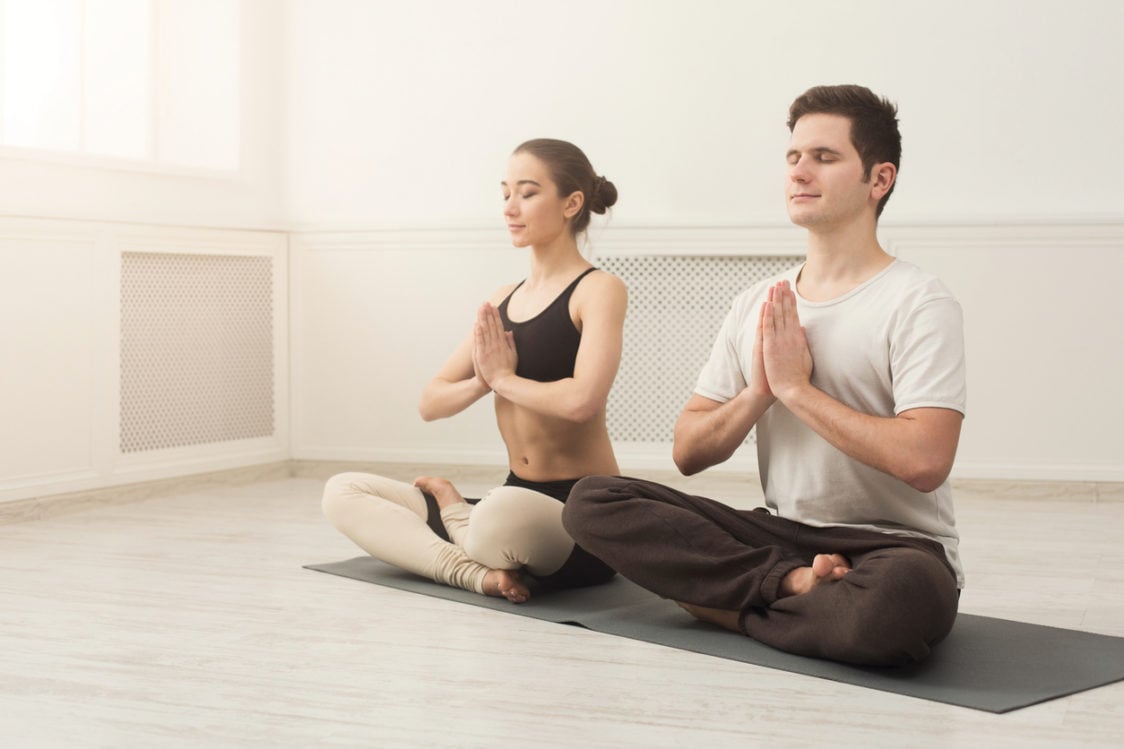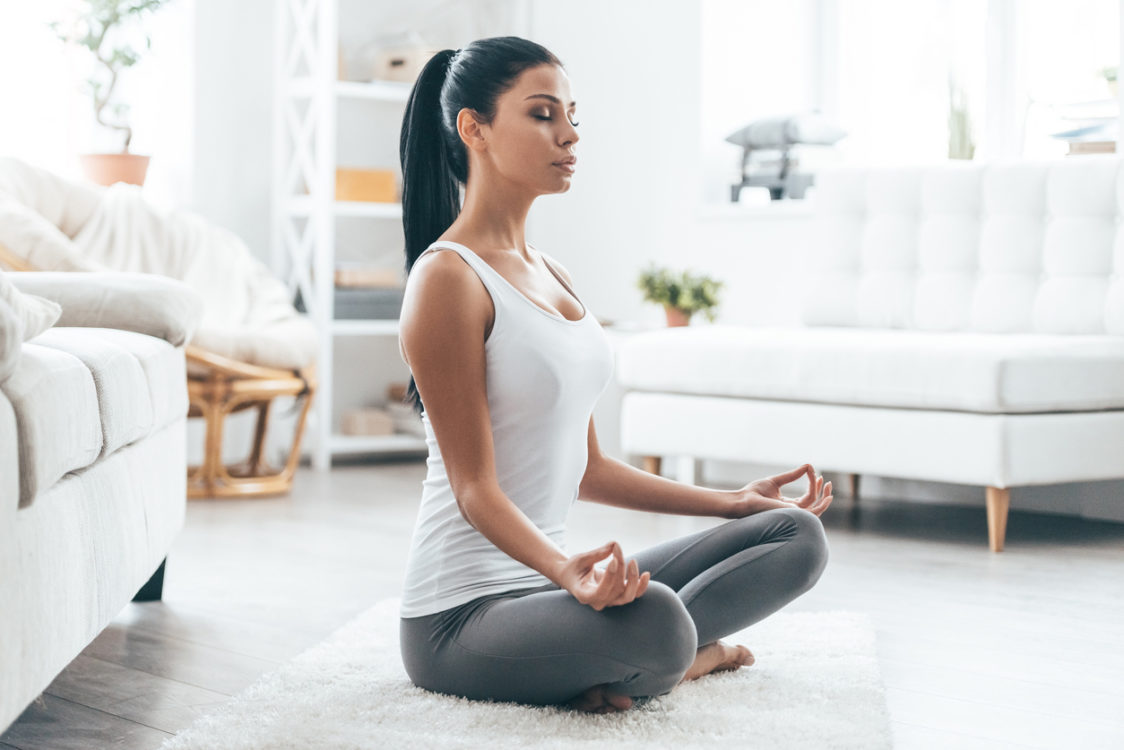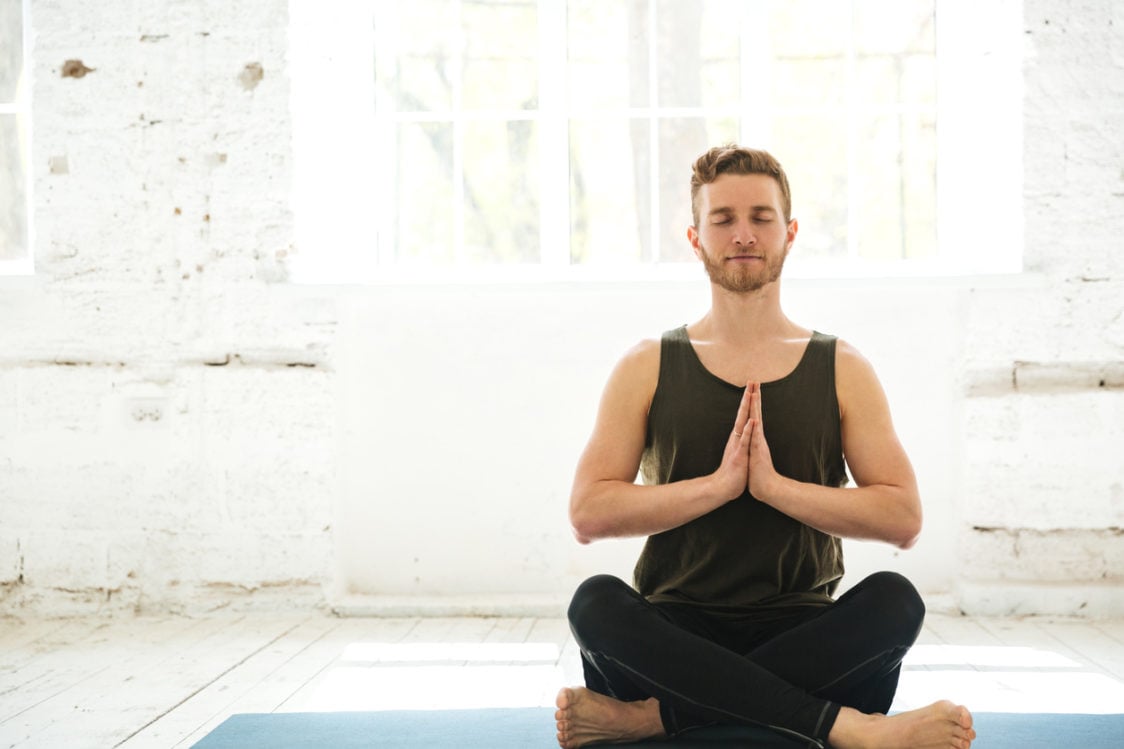Table of Contents
You could say that the times we currently live in are quite hectic. Just think of morning traffic jams or crowded public transport, where everyone is in a hurry to get something done. You rush to work, just to try to get back home as soon as possible after your shift’s over. In the meantime, you have to manage to get some shopping done as quickly as possible, and stressful days just simply push you to the limit. Maybe it’s because in general, we try to achieve too much, we want everything now and we put high demands on ourselves. However, such a lifestyle brings more harm than good. Before that happens, it is therefore a good idea to take off the gas and pay more attention to your mental well-being. One of the ways to support the so-called self-care can be meditation. In today’s article, we will look at what exactly this ancient technique contains and how it works. At the same time we will summarize the benefits that meditation can bring to our life and give tips for beginners.
- If you’re interested in more ways to slow down, read our article 8 Tips on How to Slow Down and Enjoy Life More.
What is meditation?
Meditation is an activity that involves mental and physical techniques to calm the mind and achieve inner peace. It could be said that this practice is to the mind what physical exercise is to the body. It has various forms originating from all over the world and its practice is thousands of years old. Furthermore, it can include exercises to improve concentration or conscious breath work aimed at calming or even changing consciousness. It is mostly performed individually in a calm position and with closed eyes. [1 – 2]

History of meditation
Meditation has grown in popularity only in recent years. Despite the fact that its origins go back thousands of years in history. It was originally associated with religious traditions, especially in Buddhism. It was practised throughout Asia and during the 20th century it gradually reached the whole world. In the 1960s and 1970s, it was often associated with hippie culture. Meditation is also practised in Christianity, Islam, Hinduism and Taoism. However, it is important to note that one does not have to be religious to meditate. One of the popular non-religious forms of meditation is, for example, yoga. Most types of yoga involve the practice of focusing and calming the mind, as well as conscious breathing. In the case of yoga, a form of physical exercise is also added. Therefore, yoga and meditation should be seen as two separate disciplines. [6]
- If you want to know more about it, read our article Yoga: The Key to Physical and Mental Balance.
How does meditation actually work?
Simply put, meditation calms the parts of your brain that can be overactive due to constant stimuli and daily stress. It is the hectic lifestyle that triggers bran’s alarm, thanks to which you either fight with the situation or run away from it. Accompanying feelings are usually anxiety or fear, which are responsible for being over-reactive at certain moments. An example could be a bad day at work or a traffic situation. Can you imagine that you can handle the morning rush to work with peace of mind without getting upset and honking your car horn? Then you should try meditation as it can promote peace of mind and teach you to cope better with stressful situations.
Meditation and the brain
Meditation is an activity that narrows human perception to the present moment. Studies have found that it also has an effect on the brain. This is due to the influence of meditation techniques. When you do an activity repeatedly, you strengthen your neural connections, developing related areas in your brain. For example, when you work as a courier, your daily routine develops spatial reasoning in your brain. The same process happens when you meditate. Some studies show that meditation can lead to an increase in gray matter density in the hippocampus and other areas of the brain over time. This increase, due to the involvement of the hippocampus within brain functions, supports learning, cognitive abilities and memory, leading to better processing of facts and more conscious behaviour. In practice, this could manifest itself in such a way that you will no longer react irritably to morning congestion behind the wheel and will process it much more calmly. [3 – 5]

Basic forms of meditation
Meditation itself can take many forms, but most of them are derived from two main types, which are focused meditation and mindfulness meditation.
1. Focused meditation
This form of meditation involves focusing on a specific thing using your senses. The goal is to really experience whatever you are focusing on. Whether it’s your breath, a specific word, or various other external influences. Examples can be looking at a candle flame, listening to a gong, looking at the moon or counting breaths. It sounds simple, but beginners in particular may have trouble keeping their attention on a specific thing for a long time. So in case your mind wanders, simply go back and continue. This form of meditation is ideal for anyone who wants to train their attention and concentration. [6]
How to practice focused meditation
- Sit comfortably and try to keep your back straight.
- Breathe naturally and watch your each inhale and exhale.
- Gradually start paying attention to the pauses between inhaling and exhaling.
- Try to keep your body still and breathe calmly.
- If your mind wanders, come back and continue focusing on your breathing. [9]

2. Mindfulness meditation
It is one of the most popular forms of meditation. It is based on paying attention to your thoughts as they pass through your mind. However, the thoughts are not there to be judged or engaged with. You should simply observe their flow and take in everything that passes through you. During this process, concentration is linked with awareness. This type of meditation is suitable for people who do not have a guide and would like to try meditating on their own.
Mindfulness itself could be divided into two categories [6]:
- Stress reduction (MBSR – Mindfulness-Based Stress Reduction) if you want to achieve a calm emotional state
- Cognitive therapy (MBCT – Mindfulness-Based Cognitive Therapy) with the aim of creating current awareness and liberation from excessive experience of negative patterns
In favour of mindfulness meditation also speak many studies, which found that it can [7]:
- Reduce fixation on negative emotions
- Improve concentration
- Reduce impulsive reactions
- Improve memory
- Increase satisfaction in a relationship
- Reduce stress
- Improve emotional management
How to practice mindfulness meditation
- Find a quiet place and sit down
- Set a stopwatch to end your meditation. For example, try 10 minutes to start.
- Close your eyes and focus on your breathing or on each movement of your abdomen as you inhale and exhale.
- Breathe in and out repeatedly with great concentration on this activity.
- Let your thoughts flow through you, observe them without judging or analysing them.
- End the mindfulness meditation when your stopwatch or alarm clock sounds. [9]
You might be interested in these products:
Other forms of meditation
Below is the list containing other well-known forms of meditation that bring different benefits.
1. Transcendental meditation
It is a spiritual form of meditation that takes place while sitting down with an emphasis on slow breathing. The goal is to overcome or rise above the current state of your being. While sitting, you should concentrate on your mantra, i.e. continuously repeating words, syllables or phrases either silently or aloud. An example can be the phrase – “I’m not afraid of the dark”, or anything that you would like to overcome in life. In addition, transcendental meditation can be practised with or without religious content. Its effects were monitored by a clinical study from 2014, which came to the conclusion that it can help reduce stress, depression or feelings of burnout. However, further research is still needed to better verify these results. [8]
How to practice transcendental meditation?
- Choose your specific mantra, that is, a phrase that you must repeat out loud or silently in your mind during meditation.
- Sit comfortably, close your eyes, and repeat your mantra until your designated meditation time is up.
- Try not to be distracted by other thoughts and focus only on your mantra. [9]
2. Box breathing meditation
This type of meditation can help when you are stressed out and need an instant solution to relax and calm your mind. The advantage of box breathing is that you can practice it anytime, anywhere. It works on the basis of trying to calm your mind by counting to four. That’s why the name box, because the box has four sides that represent this important number. This calming method is even used by the special forces of the US Army known as the Navy SEALs. According to a 2019 study, a controlled breathing technique can help lower levels of the stress hormone cortisol or even help lower blood pressure. [10]
How to practice box breathing meditation
- Inhale slowly for 4 seconds
- Exhale slowly for 4 seconds
- Hold your breath for 4 seconds
- Exhale slowly for 4 seconds
- Repeat 12 to 15 times as needed and don’t skimp on holding your breath. These breaks help the nervous system to relax. [9]

3. Walking meditation
This type of meditation can be an ideal alternative for anyone who does not like to sit with their eyes closed. It combines physical activity in the form of walking and concentration associated with a state of meditation. It allows you to focus on the mind-body connection while you are walking around the room or outside. You yourself determine the pace of walking and the length of concentration. During walking meditation, you should take several steps for a certain amount of time, focusing your attention on body movement and physical sensations. Walking meditation has many benefits not only for mental, but also for physical health. A 2017 study concluded that walking combined with meditation can be effective in reducing anxiety symptoms. [11 – 12]
How to practice walking meditation
- Choose the path you want to walk. For starters, consider a shorter route.
- Start walking slowly and at an even pace.
- Focus on the physical sensation of each step and calmly let your steps synchronize with your breathing.
- At the beginning, you can walk, for example, 5 minutes and then extend this time. [13]
4. Visualization meditation
It is a technique that focuses on feelings of relaxation and peace through the visualization of positive scenes or imagery. It involves trying to imagine things as vividly as possible using multiple senses. However, the foundation remains the same as with other types of meditation, with an emphasis on a straight spine, whether you sit or choose to meditate while standing. Visualization techniques are even popular among professional athletes, and stars such as elite NBA player LeBron James or former Olympic swimmer Michael Phelps use them in connection with achieving goals. For meditation, visualizing any image in which you find peace can work. Examples are scenes of the slow blooming of a flower, rays of light falling on your skin, or sea waves that move slowly to the rhythm of a gentle wind. [14 – 15]
How to practice visualization meditation
- Sit in a comfortable position without any physical tension. At the same time, try to start with a totally relaxed mind.
- Think of an image you want to visualize during the meditation.
- Use your breath as a guide throughout the meditation. Breathe in and out while synchronizing the image you are visualizing with your breathing.
- Try to keep your focus on the visualized image without your mind wandering off.
- Try to breathe naturally throughout the whole meditation. [16]

The benefits of meditation
The popularity of meditation is also growing because more and more people are discovering its benefits. Let’s talk more about them below.
1. Improves mental health
Some forms of meditation can lead to better self-knowledge and a more positive outlook on life. This could ultimately translate into overall better mental health. Various researches also speak in favour of meditation. For example, a meta-analysis that processed data from 47 studies with a total number of 3,515 participants found that mindfulness meditation helped participants alleviate symptoms of depression. The positive influence of meditation in this regard is also followed by another study from 2015. It showed that people who practice meditation have fewer negative thoughts when looking at negative images than the other group. [17 – 18]
2. Helps to reduce stress
According to the National Institute of Men’s Health, stress is the brain and body’s response to a challenge, demand, or unexpected change in your life. In a way, it is your body’s natural defence against something that makes you feel nervous, angry or frustrated. If your normal days are often accompanied by a dose of stress, you will surely appreciate that meditation could alleviate it.
A study in the journal Frontiers in Psychology also speaks in favour of this statement. It came up with the finding that mindfulness techniques, which can include meditation itself, were associated with a lower level of perceived stress. This finding is supported by an analysis of over 200 studies on meditation, which concluded that mindfulness meditation is an effective way to reduce stress. [19 – 20] [25]
- If you are further interested in the issue of stress, read our article Why Is Stress Dangerous and How to Reduce It?
- Adaptogens can also help in this direction. You can learn more about them in the article Adaptogens: Natural Substances that Help Manage Stress.
3. Improves sleep
Honestly, how many hours did you sleep last night? According to the CDC, the length of your sleep should not be less than 7 hours, and ideally it should be somewhere between 7 and 9 hours, which is quite easy to underestimate these days. However, meditation could also help in this regard. Research by Sleep magazine found that people with chronic insomnia who practised mindfulness meditation were able to sleep longer and improve symptoms of insomnia compared to the control group. Meditation has even been shown to be a possible alternative to traditional treatments for insomnia. [21 – 22]
- If you are more interested in the possibilities of improving your sleeping habits, make sure to check out our article How to Fall Asleep Quickly? Try Simple Tips for Better Sleep.
4. Helps to improve concentration
This benefit can be especially appreciated by students or people whose job content often requires a high level of concentration. Meditation is a great helper in regulating the mind, which tends to wander in different directions and divert your attention from what’s important. You may remember the last time you struggled with studying, when everything suddenly seemed more important than the activity at hand. Practising meditation regularly trains your brain. It can teach you to concentrate your thoughts on what is important and ignore distractions. [23 – 24]

5. Relieves pain
Meditation can even have an effect on alleviating physical pain. This statement is supported by a JAMA Internal Medicine review that followed more than 6,000 participants in 60 studies. Based on that, it was found that meditation can alleviate the conditions of people who suffered from post-operative, acute or chronic pain. It should be noted that meditation should be viewed as a cure-all. However, it can be beneficial in managing the chronic pain. [26]
6. Helps to fight addictions
In some cases, the mental discipline that meditation builds can help people manage their addictions. Thanks to mindfulness meditation, they can learn to redirect their attention and better manage various impulses, desires or stress. Of course, it doesn’t mean that meditation is the answer to severe addictions to drugs or alcohol. However, if you struggle, for example, with sweet cravings or frequent scrolling on social media, meditation could be one of the means to help you and at least limit these activities thanks to the attention redirection. [27]
7. Improves memory
In a 2010 study, researchers found that practising meditation has an effect on the development of gray matter in the brain, including the hippocampus. This can also have a positive effect on memory and other brain functions, such as learning or cognitive abilities, fact processing and more conscious behaviour. Meditating for 30 minutes a day for eight weeks can increase the amount of gray matter that your body produces and thus support your memory. [28]
8. Can even help you lose weight
Various studies on meditation highlight the benefits in the form of the fact that this activity helps us to relax, sleep better or concentrate. Recently, however, the interest of scientists is moving towards the question of whether meditation can help people lose weight. The answer may surprise you, because studies observe a certain impact of meditation in the process of weight loss. The main thing is that through meditation, you can manage your emotions better.
And that’s what a 2014 study is based on. It found that mindfulness meditation can help reduce the frequency of emotional overeating. Of course, this doesn’t mean that meditation will make you lose weight. However, together with a healthy diet, sports and a calorie deficit, it can be one of the parts of a well-functioning machine. Especially for people who struggle with uncontrollable food cravings. [29]

Your first meditation
On the Internet you can find many apps, guides or online procedures that can teach you how to meditate. Different types of meditation require different approaches, which were discussed above. However, there are some general guidelines to help you get started. The beauty and simplicity of meditation is that you don’t need any equipment to do it. All you need is a quiet space and a few minutes of your time every day. Many people praise morning meditation in particular, but it is up to you when this activity suits you. However, in the beginning, try to meditate at the same time every day to form a habit.
How to start meditating
- Find a calm and quiet place. You can surround it with candles, flowers, incense or any objects that support your concentration.
- Sit comfortably on a chair or on the floor, making sure your back is straight.
- Close your eyes or focus your gaze on a specific object that you have chosen for meditation.
- Breathe slowly and deeply.
- Keep your mind focused inward or on a particular object. If it wanders off, don’t panic and slowly come back.
- Exhale slowly and imagine your breath as a river that takes your thoughts away. [30]
During meditation, you can also calmly start chanting or repeating your mantra out loud. Alternatively, try meditating in the simplest form. All you have to do is find a quiet room, sit down comfortably, close your eyes and feel your natural breath. Also, keep in mind that meditation is usually easier and more successful when you detach from the idea of doing everything perfectly. Instead, pay attention to the present moment. [30]

How often should you meditate?
After your first successful meditation, you may wonder how often you should actually practice it. But the fact is that there is no definite answer to this. In the beginning, you should strive for regularity in order to get used to this new activity and gradually learn to perform it in a natural way. At the same time, any meditation is better than none. The frequency itself is then only up to you. Some people are comfortable meditating once a week, while others do it more often. You can adjust your meditation as needed. [31]
Does meditation have any downsides or risks?
When you search for more information about meditation, you will usually find only positive benefits that this activity can bring to your life. Despite this, there are also some risks associated with meditation. However, it should be added here that very few studies have examined them, and therefore it is too early to draw definite conclusions in this regard. We can mention, for example, a study from 2017 that investigated the unwanted effects of meditation in a small sample of 342 people. Issues occurred only at a rate of 4.2 to 4.6% and specifically included [31]:
- Feelings of alienation from society
- Not feeling comfortable in the world
- Feeling like you’re missing something
Research shows that most of these effects were mild and did not require the people who reported them to stop meditating. They mostly occurred in those who practised meditation privately and very often. Here, too, everything must be done in moderation, and that’s how meditation can become another piece of the puzzle of a healthy lifestyle.
Conclusion
Meditation is definitely an interesting activity that is becoming more and more popular. Many advantages supported by various scientific studies speak in its favour. You can easily find out whether meditation is for you right after reading this article. Feel free to get inspired by our beginner’s guide to help you meditate for the first time. The best part is that you don’t need any special equipment to meditate. Just try it and gradually observe the effects it can bring to your life.
[1] Meditation – https://my.clevelandclinic.org/health/articles/17906-meditation
[2] What Is Meditation? – https://liveanddare.com/what-is-meditation/
[3] Britta K. Hölzel, James Carmody, Mark Vangel, Christina Congleton, Sita M. Yerramsetti, Tim Gard, Sara W. Lazar - Mindfulness practice leads to increases in regional brain gray matter density – https://www.ncbi.nlm.nih.gov/pmc/articles/PMC3004979/
[4] Eileen Luders, Arthur W. Toga, Natasha Lepore, Christian Gaser - The underlying anatomical correlates of long-term meditation: Larger hippocampal and frontal volumes of gray matter – https://www.ncbi.nlm.nih.gov/pmc/articles/PMC3184843/
[5] Britta K. Hölzel, James Carmody, Mark Vangel, Christina Congleton, Sita M. Yerramsetti, Tim Gard,Sara W. Lazar - Mindfulness practice leads to increases in regional brain gray matter density – https://www.ncbi.nlm.nih.gov/pmc/articles/PMC3004979/
[6] Kendra Cherry - What Is Meditation? – https://www.verywellmind.com/what-is-meditation-2795927
[7] Daphne M. Davis - What are the benefits of mindfulness – https://www.apa.org/monitor/2012/07-08/ce-corner
[8] Charles Elder - Effect of Transcendental Meditation on Employee Stress, Depression, and Burnout: A Randomized Controlled Study – https://www.ncbi.nlm.nih.gov/pmc/articles/PMC3951026/
[9] 10 Types of Meditation and How to Do Them – https://psychcentral.com/health/types-of-meditation#transcendental
[10] Susan I Hopper, Sherrie L Murray, Lucille R Ferrara, Joanne K Singleton - Effectiveness of diaphragmatic breathing for reducing physiological and psychological stress in adults: a quantitative systematic review – https://pubmed.ncbi.nlm.nih.gov/31436595/
[11] Walking Meditation Guide: How to Meditate While Walking – https://www.masterclass.com/articles/walking-meditation-guide
[12] Meghan K. Edwards, Simon Rosenbaum, Paul D. Loprinzi - Differential Experimental Effects of a Short Bout of Walking, Meditation, or Combination of Walking and Meditation on State Anxiety Among Young Adults – https://journals.sagepub.com/doi/10.1177/0890117117744913
[13] Walking Meditation – https://ggia.berkeley.edu/practice/walking_meditation
[14] Jo Nash - How to Practice Visualization Meditation: 3 Best Scripts – https://positivepsychology.com/visualization-meditation/
[15] Kristine Moe - 5 visualization techniques to help you reach your goals – https://www.betterup.com/blog/visualization
[16] Karin Matko, Peter Sedlmeier - What Is Meditation? Proposing an Empirically Derived Classification System – https://www.ncbi.nlm.nih.gov/pmc/articles/PMC6803504/
[17] Madhav Goyal, Sonal Singh, Erica M S Sibinga, Neda F Gould - Meditation programs for psychological stress and well-being: a systematic review and meta-analysis – https://pubmed.ncbi.nlm.nih.gov/24395196/
[18] Laura G. Kiken, Natalie J. Shook - Does mindfulness attenuate thoughts emphasizing negativity, but not positivity? – https://www.ncbi.nlm.nih.gov/pmc/articles/PMC4178287/
[19] I’m So Stressed Out! Fact Sheet – https://www.nimh.nih.gov/health/publications/so-stressed-out-fact-sheet
[20] Larissa Bartlett, Marie-Jeanne Buscot, Aidan Bindoff, Richard Chambers, Craig Hassed - Mindfulness Is Associated With Lower Stress and Higher Work Engagement in a Large Sample of MOOC Participants – https://www.frontiersin.org/articles/10.3389/fpsyg.2021.724126/full
[21] How Much Sleep Do I Need? – https://www.cdc.gov/sleep/about_sleep/how_much_sleep.html
[22] Jason C. Ong, Rachel Manber, Zindel Segal, Yinglin Xia, Shauna Shapiro, James K. Wyatt - A Randomized Controlled Trial of Mindfulness Meditation for Chronic Insomnia – https://academic.oup.com/sleep/article/37/9/1553/2416992
[23] Chakravarthi Annam - Meditation – https://heartfulness.org/en/what-is-meditation/
[24] Shilo Rea - Neurobiological Changes Explain How Mindfulness Meditation Improves Health – https://www.cmu.edu/news/stories/archives/2016/february/meditation-changes-brain.html
[25] Bassam Khoury a, Tania Lecomte, Guillaume Fortin, Marjolaine Masse, Phillip Therien - Mindfulness-based therapy: A comprehensive meta-analysis – https://www.sciencedirect.com/science/article/abs/pii/S0272735813000731?via=ihu
[26] Eric L. Garland, Carrie E. Brintz, Adam W. Hanley - Mind-Body Therapies for Opioid-Treated Pain – https://jamanetwork.com/journals/jamainternalmedicine/article-abstract/2753680
[27] Sarah E Priddy, Matthew O Howard, Adam W Hanley, Michael R Riquino, Katarina Friberg-Felsted, Eric L Garland - Mindfulness meditation in the treatment of substance use disorders and preventing future relapse: neurocognitive mechanisms and clinical implications – https://www.ncbi.nlm.nih.gov/pmc/articles/PMC6247953/
[28] Britta K. Hölzel, James Carmody, Mark Vangel, Christina Congleton, Sita M. Yerramsetti, Tim Gard, Sara W. Lazara - Mindfulness practice leads to increases in regional brain gray matter density – https://www.ncbi.nlm.nih.gov/pmc/articles/PMC3004979/
[29] Shawn N. Katterman, Brighid M. Kleinman, Megan M. Hood, Lisa M. Nackers, Joyce A. Corsica - Mindfulness meditation as an intervention for binge eating, emotional eating, and weight loss: A systematic review – https://www.sciencedirect.com/science/article/abs/pii/S1471015314000191?via%3Dihub
[30] What meditation can do for your mind, mood, and health – https://www.health.harvard.edu/staying-healthy/what-meditation-can-do-for-your-mind-mood-and-health-
[31] Zawn Villines - What is the best type of meditation? – https://www.medicalnewstoday.com/articles/320392#how-often-to-meditate
[32] Unwanted effects: Is there a negative side of meditation? A multicentre survey – https://www.ncbi.nlm.nih.gov/pmc/articles/PMC5584749/


Add a comment